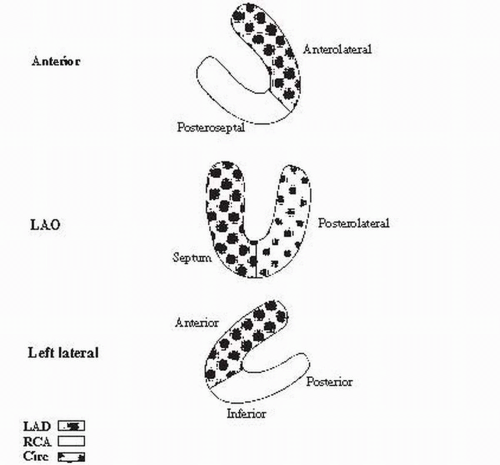Patient group |
Condition |
Imaging technique |
ER patient with chest pain |
For risk stratification in pt with possible ACS. Initial serum markers and enzymes. ECG is nondiagnostic. |
Rest perfusion imaging (with ECG gating, if possible). |
|
For CAD diagnosis in pt with possible ACS and nondiagnostic ECG. Negative serum markers and enzymes or normal rest perfusion scan. |
Same-day rest/stress (ECG-gated) myocardial perfusion imaging. |
Acute MI/unstable angina |
Assessment of LV function. |
Rest myocardial perfusion imaging with ECG gating (rest gated radionuclide angiography is alternative option). |
ST-elevation MI |
Measurement of infarct size and residual viable myocardium, in an unrevascularized asymptomatic stable patient after completion of the infarct. |
Rest myocardial perfusion imaging with ECG gating or with stress perfusion imaging with ECG gating. |
|
Thrombolysis without coronary angiogram, to identify inducible ischemia and myocardium at risk. |
Rest and stress myocardial perfusion imaging, with ECG gating whenever possible. |
Non-ST-elevation MI/unstable angina |
In an unrevascularized stable asymptomatic patient after completion of the infarct, to determine the extent and severity of inducible ischemia, either in the distribution of the “culprit” vessel or in remote myocardium. |
Rest and stress myocardial perfusion imaging, with ECG gating whenever possible. |
|
In individuals whose angina is stabilized on medical therapy or in whom the diagnosis is uncertain, to identify the extent and severity of inducible ischemia. |
Rest and stress myocardial perfusion imaging, with ECG gating whenever possible. |
|
To assess the functional significance of a coronary stenosis on angiography. |
Rest and stress myocardial perfusion imaging. |
CAD diagnosis in an individual with an intermediate probability of disease and/or risk stratification in someone with an intermediate or high likelihood of disease and able to exercise to 85% MPHR or more |
Those with pre-excitation, LVH, on digoxin, or >1 mm ST-segment depression on resting ECG. |
Rest and exercise stress myocardial perfusion imaging, with ECG gating whenever possible. |
|
Individuals with left bundle branch block or ventricular-paced rhythm. |
Rest and vasodilator stress myocardial perfusion imaging, with ECG gating whenever possible. |
|
Patients with an intermediate- or high-risk Duke treadmill score. |
Rest and exercise stress myocardial perfusion imaging, with ECG gating whenever possible. |
|
In an individual with prior abnormal myocardial perfusion scan and new or worsening symptoms. |
Repeat rest and exercise stress myocardial perfusion imaging, with ECG gating whenever possible. |
CAD diagnosis in an individual with an intermediate probability of disease and/or risk stratification in someone with an intermediate or high likelihood of disease and not able to exercise |
To identify the extent, severity, and location of inducible ischemia. |
Rest and vasodilator stress myocardial perfusion imaging, with ECG gating whenever possible. |
Detection of CAD in patients with ventricular tachycardia |
Patients without known CAD or ischemic equivalent. |
Rest and stress myocardial perfusion imaging, preferably exercise stress, with ECG gating whenever possible. |
Detection of CAD in patients with syncope. |
Patients with intermediate and high risk for CHD and no ischemic equivalent. |
Rest and stress myocardial perfusion imaging, preferably exercise stress, with ECG gating whenever possible. |
Prior to intermediate- and high-risk noncardiac surgery |
Initial diagnosis of CAD in those with at least one clinical risk factor for adverse perioperative CV events, and poor (<4 METSs) or unknown functional capacity. |
In those able to exercise, rest and exercise stress myocardial perfusion imaging, with ECG gating whenever possible |
|
|
or |
|
|
In those unable to exercise, rest and vasodilator stress myocardial perfusion imaging, with ECG gating whenever possible. |
|
In individuals with established or suspected CAD and poor (<4 METS) or unknown functional capacity. |
In those able to exercise, rest and exercise stress myocardial perfusion imaging, with ECG gating whenever possible |
|
|
or |
|
|
In those unable to exercise, rest and vasodilator stress myocardial perfusion imaging, with ECG gating whenever possible. |
|
Diagnosis of CAD in patients with left bundle branch block or ventricular-paced rhythm and at least one risk factor for adverse perioperative CV events. |
Rest and vasodilator stress myocardial perfusion imaging, with ECG gating whenever possible. |
|
In suspected or established CAD, prognostic assessment of those with left bundle branch block or ventricular-paced rhythm on rest ECG. |
Rest and vasodilator stress myocardial perfusion imaging, with ECG gating whenever possible. |
Equivocal SPECT myocardial perfusion scan |
Clinically indicated SPECT perfusion study is equivocal for CAD diagnosis or risk stratification purposes. |
Rest and adenosine or dipyridamole stress PET myocardial perfusion study. |
CAD patient with systolic dysfunction and CHF, with little or no angina |
Prediction of improvement in regional/global LV function following revascularization. |
Stress/redistribution/reinjection thallium 201 SPECT perfusion imaging |
|
|
or |
|
|
Rest/redistribution SPECT perfusion imaging |
|
|
or |
|
|
Myocardial perfusion plus FDG PET metabolic imaging |
|
|
or |
|
|
Resting sestamibi SPECT perfusion imaging. |
|
Prediction of improvement in natural history following revascularization. |
Stress/redistribution/reinjection thallium 201 SPECT perfusion imaging |
|
|
or |
|
|
Rest/redistribution thallium 201 SPECT perfusion imaging |
|
|
or |
|
|
Myocardial perfusion plus FDG PET metabolic imaging. |
ACS, acute coronary syndrome; CAD, coronary artery disease; CHF, congestive heart failure; CV, cardiovascular; ECG, electrocardiogram; ER, emergency room; FDG, [18F]fluoro-2-deoxyglucose; LV, left ventricular; LVH, left ventricular hypertrophy; MI, myocardial infarction; MPHR, maximal age-predicted heart rate; PET, positron emission tomography; pt, patient; SPECT, single-photon emission computed tomography. |




